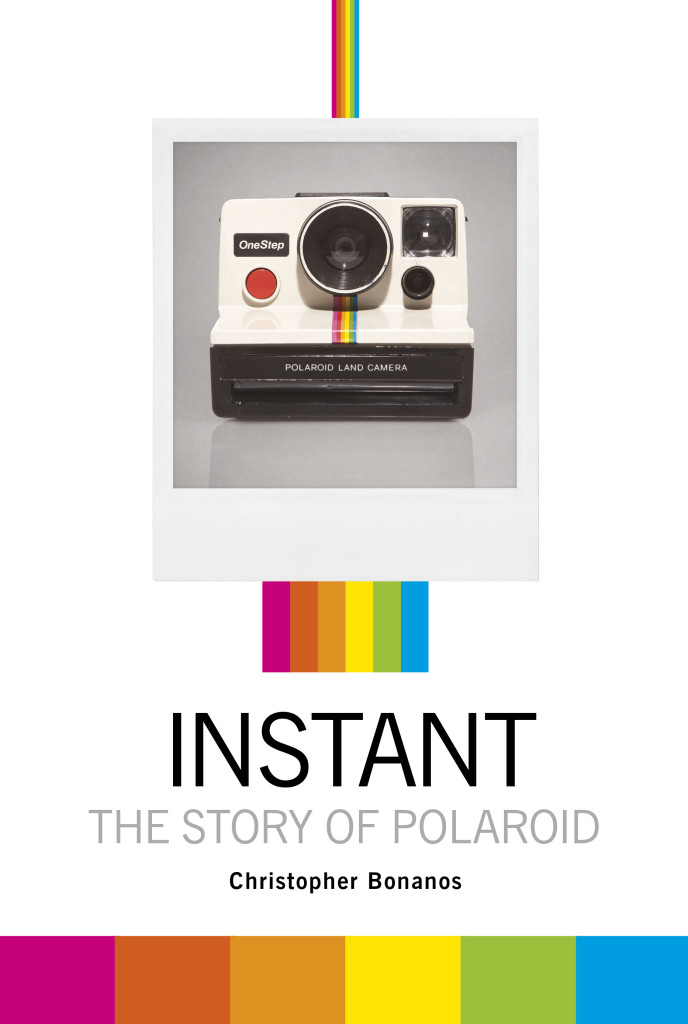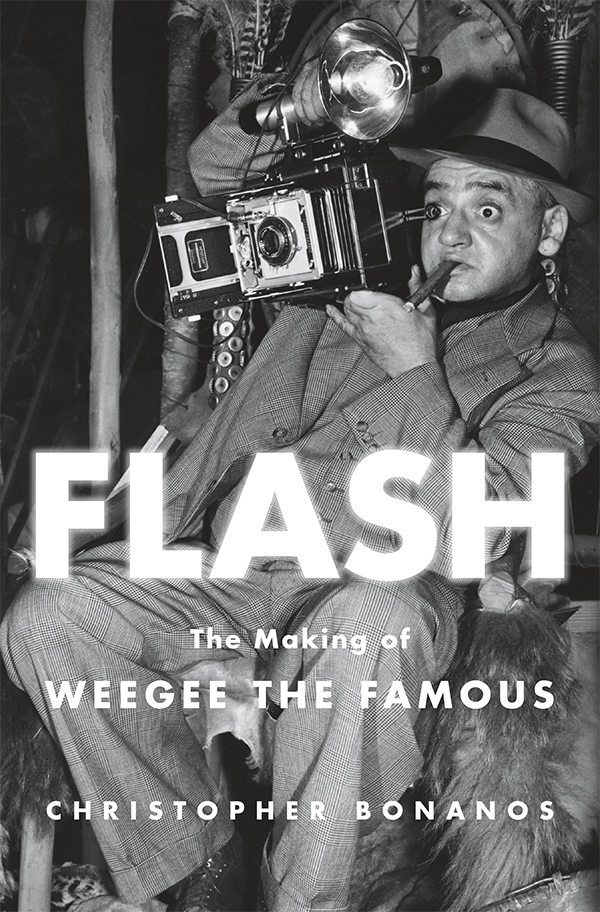INSTANT: THE STORY OF POLAROID is a book about a very unusual company. In the 1960s and 1970s, Polaroid was what Apple is today: the coolest technology company on earth, the one with irresistible products, the one whose stock kept climbing way past the point of logic. In its heyday, Polaroid was an absolute innovation machine—a scientific think tank that periodically kicked out a fantastically profitable, covetable product. In fact, the late Steve Jobs expressly said that he modeled his company to a great extent after Polaroid.
Like Apple, Polaroid had a genius-visionary founder, a man who both served as the company’s public face and drove its creativity. Edwin Land was a Harvard dropout whose first invention—the thin celluloid filter known as a polarizer—was enough to get a little company off the ground. As that startup grew, Land’s ability as an inventor came into flower, and in 1947 he unveiled the latest in a series of extraordinary ideas: the Polaroid Land* camera system, one that produced photographs instantly. At a time when most photographers sent off their film by mail for processing, it was stunning. Instead of waiting a week, you had a photo in 60 seconds. If your picture came out lousy, you could try taking it again before the moment evaporated. Nothing else worked like this.
The world responded. By the mid-fifties, Polaroid was growing like crazy; by the sixties it was a major corporation, seemingly unstoppable. In 1972, Land launched the product that he considered the company’s crowning achievement: the SX-70 camera system. That’s the one most of us recognize as “Polaroid,” with photos that have a fat white tab at the bottom of the frame. He had bet the company on an entirely new product, one based on a murderously complex new set of technologies, and he succeeded, spectacularly. (Though it was touch-and-go the first year, as awful production problems had to be ironed out.) In 1974, a billion Polaroid photos were taken. A few years later, the company reached a billion dollars in annual sales. Eastman Kodak tried to get a piece of their action by introducing its own instant-photography line, and Polaroid sued and (after nearly fifteen years’ litigation) won. Kodak had to pay $925 million in damages, and even had to buy back all the instant cameras it had sold. Until the Apple-Samsung judgment of 2012—yet another parallel!—it was the largest patent settlement ever paid out.
Though it’s often perceived as something for snapshots only, Polaroid film—especially in its professional formats—was an extraordinary photographic tool, and was embraced by some of the era’s great artists. Ansel Adams loved Polaroid, and shot some of his most famous images of Yosemite National Park on Polaroid film. Walker Evans and André Kertész each adopted an SX-70 late in life, when a big traditional camera became cumbersome, and each made beautiful photographs on it. A very special and enormous camera, shooting giant images (20 by 24 inches) that have to be seen to be believed, has been used by everyone from Andy Warhol to Chuck Close to Mary Ellen Mark, and is still in operation.
And then it all came apart. In the late 1970s, Land pushed through a product line that his colleagues knew to be a dog: an instant 8-mm. movie system called Polavision. He insisted it would take off, and it bombed. Suddenly Land was fallible, after a spotless 40-year record, and in 1982, he was nudged into retirement. His two immediate successors had worked for Polaroid for decades, and they made some good choices and some less good ones. Whomever you blame, though, Polaroid’s innovation machine began to cool down, and its latter-day leaders did not have the vision to embrace two technologies—digital photography and inkjet printing—that were percolating around in its labs. Instead they doubled down on selling and refining instant film, and built up some debt fighting off a hostile takeover. When digital photography swept in and took over the entire business, in the late 1990s, Polaroid—despite twenty years’ advance notice, from within and without—got clobbered.
Since 2001, Polaroid has declared bankruptcy twice and been sold three times. One of those owners is in prison for running a $3 billion Ponzi scheme (in fact, he bought Polaroid out of bankruptcy for its cash flow and salable assets, in order to sustain the fraud). Camera production ceased in 2006; film production, in 2008.
For several years thereafter, Polaroid was operated as a joint venture between two companies, Hilco and Gordon Brothers, who rehab distressed brands, with some additional investment by the Pohlad family of Minnesota. They ran it mostly it as a licensing company, partnering with other manufacturers to put a familiar old name on those companies’ stuff (digital cameras, flat TVs, and the like). During that period, a few small-scale enthusiasts, notably one begun as The Impossible Project, have picked up pieces of Polaroid’s analog past, effectively re-inventing instant film with new chemical formulas to replace the irreplicable older ones. (Their early products were extremely flawed but promising; the recent film is dramatically improved. Much more about the particulars here.) Fujifilm of Japan has stopped making peel-apart film for Polaroid’s old cameras, but it has had great success with its own Instax line . In 2017, Impossible’s chief investor bought the Polaroid brand from the partnership, and Impossible became Polaroid Originals. The minnow has swallowed the whale.
INSTANT is a business story, about what happens when a company loses its innovative spark. It is a fine-arts story, showcasing the amazing things people did with Polaroid film. It is a technology story, of a company that created and maintained a niche all its own for 60 years. And it is a pop-culture history, of a friendly product that millions of people absolutely adored. I like to think that it also tells a larger story, about the rise and fall of American invention and manufacturing.
INSTANT: THE STORY OF POLAROID was published by the excellent Princeton Architectural Press on September 28, 2012. It is available (as the expression goes) in all fine bookstores. PAP also produced a special slipcased limited edition sold only through The Impossible Project, and although Impossible no longer has copies available, copies occasionally appear on the secondhand market and on eBay. In 2014, INSTANT was chosen as the First-Year Book by the University of Maryland, and that site is here.
*The name of this site is not a coincidence.
18 Responses to The Book
Leave a ReplyCancel reply
LEGALITIES
This site is not connected with or endorsed by Polaroid or PLR IP Holdings, owners of the Polaroid trademark.ON TWITTER
My TweetsBlogroll
- 'Insisting on the Impossible'
- Everything Reminds Me of You
- Flickr's Polaroid group
- Instant Options
- LandCameras.com
- Paul Giambarba: Analog Photography At Its Best
- Paul Giambarba: The Branding of Polaroid
- Polaroid
- Polaroid SF
- Rare Medium
- The Impossible Project
- The Land List
- The New55 Project
- Vintage Instant





Love the title, Chris. Instant says it all. Best, Paul
[…] his wonderful book INSTANT, the Story of Polaroid, Christopher Bonanos describes a scene in 1970 when Edwin Land, inventor of the Polaroid camera […]
[…] Läs mer om boken och Polaroid på författaren Christopher Bonanos hemsida Polaroidland. […]
[…] Instant: The Story of Polaroid by Christopher Bonanos– Even if you’re not into instant photography, this glimpse inside Edwin Land’s empire is worth reading. Polaroid’s innovation (and demise) is equal parts instruction manual and warning label for all types of companies. You’ll find yourself looking at today’s tech industry a little differently after reading this book. […]
[…] off the pictures – an act which, as Christopher Bonanos, author of the excellent book Instant: The Story of Polaroid, pointed out to me, was probably done to squeeze them into a standard-sized frame or […]
[…] a history of the 20th century’s high-tech-quickie-photograph-turned-pop-culture-obsession, in Instant: The Story of Polaroid (Princeton Architectural Press). Drawing on interviews and previously hidden archives—which went […]
Hey Chris, you came to My college (NYU Poly) a few weeks ago to discuss your book. You immediately caught my attention with the story you told us. Now for the english class we have to write about a innovation that had lasting impacts. Guess what i picked =D. Just wanted to say thanks for opening my eyes into such an amazing story and helping me come with a great essay idea.
[…] week’s post is the third in a series of posts reflecting on the book Instant: The Story of Polaroid by Christopher Bonanos. If you’re interested, you can find the first two posts here and here. […]
[…] new book, Instant: The Story of Polaroid, chronicles the history of instant cameras. The fastest form of film photography, easily adopted by […]
[…] a new era for photography. In the 1960s and 1970s, Polaroid was THE “it” company, with some even likening the company’s influence and style to Apple’s today. Polaroid was trendy, cool and […]
[…] finding my expired type 55 polaroid film, finding a darkroom to print, reading INstant the story of polaroid, adding a 250 Land Camera from Shutter + Light I have been obsessed and have become a backer of […]
[…] The Book | Polaroidland – INSTANT: THE STORY OF POLAROID is a book about a very unusual company. In the 1960s and 1970s, Polaroid was what Apple is today: the coolest technology company … […]
[…] The Book | Polaroidland – INSTANT: THE STORY OF POLAROID is a book about a very unusual company. In the 1960s and 1970s, Polaroid was what Apple is today: the coolest technology company … […]
[…] just recently read Christopher Bonanos‘ Instant – The Story of Polaroid in a special limited edition published by Princeton Architectural Press, October 2012. On the back […]
[…] einen gewissen Kultstatus des kreativen self-made Man ausstrahlen. Wie der amerikanische Blogger Christopher Bonanos betont, war die Polaroid Firma früher, was Apple jetzt ist. In den digitalen Polaroidfiltern, die […]
[…] feed this morning, I saw a horrifying note from Christopher Bonanos, author of the excellent Instant: The Story of Polaroid: FujiFilm is discontinuing production of FP100C, the last film it made for these […]
[…] but data insights may have given Polaroid’s leaders a new view on the profitability of its inkjet printer business – especially since “printer ink costs more than blood by volume and more than caviar by […]
[…] Christopher Bonanos, Instant: The Story of Polaroid […]